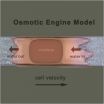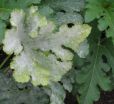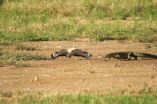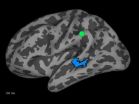(Press-News.org) New York, NY—April 30, 2014—Researchers at Columbia Engineering announced today that they have successfully grown fully functional human cartilage in vitro from human stem cells derived from bone marrow tissue. Their study, which demonstrates new ways to better mimic the enormous complexity of tissue development, regeneration, and disease, is published in the April 28 Early Online edition of Proceedings of the National Academy of Sciences (PNAS).
"We've been able—for the first time—to generate fully functional human cartilage from mesenchymal stem cells by mimicking in vitro the developmental process of mesenchymal condensation," says Gordana Vunjak-Novakovic, who led the study and is the Mikati Foundation Professor of Biomedical Engineering at Columbia Engineering and professor of medical sciences. "This could have clinical impact, as this cartilage can be used to repair a cartilage defect, or in combination with bone in a composite graft grown in lab for more complex tissue reconstruction."
For more than 20 years, researchers have unofficially called cartilage the "official tissue of tissue engineering," Vunjak-Novakovic observes. Many groups studied cartilage as an apparently simple tissue: one single cell type, no blood vessels or nerves, a tissue built for bearing loads while protecting bone ends in the joints. While there has been great success in engineering pieces of cartilage using young animal cells, no one has, until now, been able to reproduce these results using adult human stem cells from bone marrow or fat, the most practical stem cell source. Vunjak-Novakovic's team succeeded in growing cartilage with physiologic architecture and strength by radically changing the tissue-engineering approach.
The general approach to cartilage tissue engineering has been to place cells into a hydrogel and culture them in the presence of nutrients and growth factors and sometimes also mechanical loading. But using this technique with adult human stem cells has invariably produced mechanically weak cartilage. So Vunjak-Novakovic and her team, who have had a longstanding interest in skeletal tissue engineering, wondered if a method resembling the normal development of the skeleton could lead to a higher quality of cartilage.
Sarindr Bhumiratana, postdoctoral fellow in Vunjak-Novakovic's Laboratory for Stem Cells and Tissue Engineering, came up with a new approach: inducing the mesenchymal stem cells to undergo a condensation stage as they do in the body before starting to make cartilage. He discovered that this simple but major departure from how things were usually? being done resulted in a quality of human cartilage not seen before.
Gerard Ateshian, Andrew Walz Professor of Mechanical Engineering, professor of biomedical engineering, and chair of the Department of Mechanical Engineering, and his PhD student, Sevan Oungoulian, helped perform measurements showing that the lubricative property and compressive strength—the two important functional properties—of the tissue-engineered cartilage approached those of native cartilage. The researchers then used their method to regenerate large pieces of anatomically shaped and mechanically strong cartilage over the bone, and to repair defects in cartilage.
"Our whole approach to tissue engineering is biomimetic in nature, which means that our engineering designs are defined by biological principles," Vunjak-Novakovic notes. "This approach has been effective in improving the quality of many engineered tissues—from bone to heart. Still, we were really surprised to see that our cartilage, grown by mimicking some aspects of biological development, was as strong as 'normal' human cartilage."
The team plans next to test whether the engineered cartilage tissue maintains its structure and long-term function when implanted into a defect.
"This is a very exciting time for tissue engineers," says Vunjak-Novakovic. "Stem cells are transforming the future of medicine, offering ways to overcome some of the human body's fundamental limitations. We bioengineers are now working with stem cell scientists and clinicians to develop technologies that will make this dream possible. This project is a wonderful example that we need to 'think as a cell' to find out how exactly to coax the cells into making a functional human tissue of a specific kind. It's emblematic of the progress being driven by the exceptional young talent we have among our postdocs and students at Columbia Engineering."
INFORMATION:
The study was funded by the National Institutes of Health (National Institute for Biomedical Imaging and Bioengineering, National Institute for Dental and Craniofacial Research, and National Institute for arthritis and musculoskeletal diseases).
Columbia engineers grow functional human cartilage in lab
First time physiologically strong cartilage has been made in vitro from human stem cells
2014-04-30
ELSE PRESS RELEASES FROM THIS DATE:
Throwing injuries no longer just for the pros
2014-04-30
ROSEMONT, Ill.—Baseball season is back and so are the injuries. But, elbow injuries, once seen as a problem for professional athletes, are becoming more prevalent among high school and middle school athletes due to increased play and competition at the youth level. Repetitive stress to a pitcher's ulnar collateral ligament (UCL)—an important stabilizing ligament of the elbow joint—can lead to pain and eventually to the inability to pitch and throw.
According to a literature review in the May 2014 issue of the Journal of the American Academy of Orthopaedic Surgeons (JAAOS), ...
Research finds a way to protect crops from pests and disease
2014-04-30
A team of international researchers has uncovered a mechanism by which plants are able to better defend themselves against disease-causing pathogens.
The work, led by Dr Jurriaan Ton and Dr Estrella Luna at the University of Sheffield, has identified the key receptor binding a chemical called BABA (β-aminobutyric acid) which is boosting plant immunity.
BABA has long been known for its protective effects against devastating plant diseases, such as potato blight, but has so far not been used widely in crop protection because of undesirable side effects.
"We have ...
Robots may need to include parental controls
2014-04-30
Older adults' fears that companion robots will negatively affect young people may create design challenges for developers hoping to build robots for older users, according to Penn State researchers.
Companion robots provide emotional support for users and interact with them as they, for example, play a game, or watch a movie.
Older adults reported in a study that while they were not likely to become physically and emotionally dependent on robots, they worried that young people might become too dependent on them, said T. Franklin Waddell, a doctoral candidate in mass ...
Water-based 'engine' propels tumor cells through tight spaces in the body
2014-04-30
Johns Hopkins researchers have discovered a new mechanism that explains how cancer cells spread through extremely narrow three-dimensional spaces in the body by using a propulsion system based on water and charged particles.
The finding, reported in the April 24 issue of the journal Cell, uncovers a novel method the deadly cells use to migrate through a cancer patient's body. The discovery may lead to new treatments that help keep the disease in check. The work also points to the growing importance of studying how cells behave in three dimensions, not just atop flat two-dimensional ...
Frog eggs Help MU researchers find new information on grapevine disease
2014-04-30
COLUMBIA, Mo. – Vitis vinifera are common grapevines and are the world's favorite wine-producing varietal. However, research has shown that grapevines are susceptible to powdery mildew, a plant disease, which contributes to significant crop loss for most commercial wine varietals that are cultivated each year. Now, researchers at the University of Missouri have used frog eggs to determine the cause of this disease, and have found that a specific gene in the varietal Cabernet Sauvingon, contributes to its susceptibility.
"Powdery mildew disease causes the leaves of the ...
Predators predict longevity of birds
2014-04-30
This news release is available in German. Ageing inevitably occurs both in humans and in other animals. However, life-span varies widely across species. Researchers of the Max Planck Institute for Ornithology in Seewiesen have now found a possible general mechanism explaining differences in longevity. They investigated life history data of nearly 1400 bird species and found that avian life span varies considerably across the entire Earth, and that much of this variation can be explained by the species' body mass and clutch size and by the local diversity of predator ...
Your stress is my stress
2014-04-30
This news release is available in German. Stress is contagious. Observing another person in a stressful situation can be enough to make our own bodies release the stress hormone cortisol. This is the conclusion reached by scientists involved in a large-scale cooperation project between the departments of Tania Singer at the Max Planck Institute for Cognitive and Brain Sciences in Leipzig and Clemens Kirschbaum at the Technische Universität Dresden. Empathic stress arose primarily when the observer and stressed individual were partners in a couple relationship and the ...
A fattening gene
2014-04-30
This news release is available in German. The long-term consumption of too much high-energy and high-fat food leads to overweight. Behind this trivial statement lies the extremely complex regulation of lipid metabolism. Together with colleagues from Japan, scientists from the Max Planck Institute for Heart and Lung Research in Bad Nauheim have now discovered that the Sirt7 gene plays a central role in energy metabolism. Despite consuming high-fat food, genetically modified mice that lack the gene maintain their normal weight.
Food was not always available to such ...
In recognizing speech sounds, the brain does not work the way a computer does
2014-04-30
VIDEO:
Patterns of activation induced by listening to human speech move across brain hemispheres over a period of 300 milliseconds in these images, produced by combining data from EEG, MEG and...
Click here for more information.
How does the brain decide whether or not something is correct? When it comes to the processing of spoken language – particularly whether or not certain sound combinations are allowed in a language – the common theory has been that the brain applies a ...
Social media users need help to adjust to interface changes
2014-04-30
Social media companies that give users a greater sense of control can ease them into interface changes, as well as curb defections to competitors, according to researchers.
"Several studies have looked into how social media companies have failed," said Pamela Wisniewski, a post-doctoral scholar in information sciences and technology, Penn State. "What we need to think about is how social media companies can be more adaptive and how they can improve the longevity of their sites.
In a study of the reaction to the introduction of Facebook's Timeline interface between 2011 ...
LAST 30 PRESS RELEASES:
CRISPR primes goldenberry for fruit bowl fame
Mass General Brigham announces new AI company to accelerate clinical trial screening and patient recruitment
Fat tissue around the heart may contribute to greater heart injury after a heart attack
Jeonbuk National University researcher proposes a proposing a two-stage decision-making framework of lithium governance in Latin America
Chromatin accessibility maps reveal how stem cells drive myelodysplastic progression
Cartilaginous cells regulate growth and blood vessel formation in bones
Plant hormone allows lifelong control of proteins in living animal for first time
Swedish freshwater bacteria give new insights into bacterial evolution
Global measures consistently underestimate food insecurity; one in five who suffer from hunger may go uncounted
Hidden patterns of isolation and segregation found in all American cities
FDA drug trials exclude a widening slice of Americans
Sea reptile’s tooth shows that mosasaurs could live in freshwater
Pure bred: New stem cell medium only has canine components
Largest study of its kind highlights benefits – and risks – of plant-based diets in children
Synergistic effects of single-crystal HfB2 nanorods: Simultaneous enhancement of mechanical properties and ablation resistance
Mysterious X-ray variability of the strongly magnetized neutron star NGC 7793 P13
The key to increasing patients’ advance care medical planning may be automatic patient outreach
Palaeontology: Ancient tooth suggests ocean predator could hunt in rivers
Polar bears may be adapting to survive warmer climates, says study
Canadian wildfire smoke worsened pediatric asthma in US Northeast: UVM study
New UBCO research challenges traditional teen suicide prevention models
Diversity language in US medical research agency grants declined 25% since 2024
Concern over growing use of AI chatbots to stave off loneliness
Biomedical authors often call a reference “recent” — even when it is decades old, analysis shows
The Lancet: New single dose oral treatment for gonorrhoea effectively combats drug-resistant infections, trial finds
Proton therapy shows survival benefit in Phase III trial for patients with head and neck cancers
Blood test reveals prognosis after cardiac arrest
UBCO study finds microdosing can temporarily improve mood, creativity
An ECOG-ACRIN imaging study solves a long-standing gap in metastatic breast cancer research and care: accurately measuring treatment response in patients with bone metastases
Cleveland Clinic presents final results of phase 1 clinical trial of preventive breast cancer vaccine study
[Press-News.org] Columbia engineers grow functional human cartilage in labFirst time physiologically strong cartilage has been made in vitro from human stem cells





